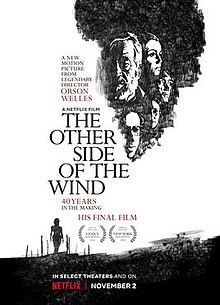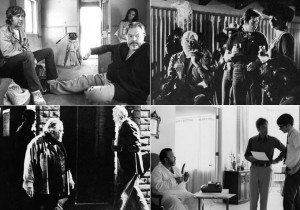Orson Welles  died in October of 1985. His last film, The Other Side of the Wind, was finally released in latter 2018. The late director worked intermittently on the project from 1970 until his death. It was unfinished and stuck in legal limbo until Netflix took on the sizable task of assembling a final cut from Welles’ 100 or so hours of raw footage. The result might not be the cinematic masterpiece so long anticipated, but it is an interesting look at the mindset of a Hollywood legend as he tilted at his final windmill.
died in October of 1985. His last film, The Other Side of the Wind, was finally released in latter 2018. The late director worked intermittently on the project from 1970 until his death. It was unfinished and stuck in legal limbo until Netflix took on the sizable task of assembling a final cut from Welles’ 100 or so hours of raw footage. The result might not be the cinematic masterpiece so long anticipated, but it is an interesting look at the mindset of a Hollywood legend as he tilted at his final windmill.
The Other Side of the Wind presents an intermingling of plots, or in some cases mere estimations of plots. Its outermost layer is the last day in the life of esteemed filmmaker Jake Hannaford, a role so blatantly autobiographical that it’ll be an enduring mystery why Welles tapped John Huston instead of playing it himself. This drama is interspersed with scenes from Hannaford’s unfinished swan song, an experimental film perhaps inevitably titled The Other Side of the Wind.
This recursive self-reference becomes a metaphor, quite possibly an unintended one, for Welles’ own struggle to produce a coherent film structure out of a collection of snippets. It’s said that throughout the long life of the project Welles’ scope and intentions were constantly changing—early on, apparently, the “star” of the film-within-the-film was to be the 1970s impressionist Rich Little, in his first dramatic role. He grew frustrated with Welles’ amorphous direction and walked off the set; as a result his presence is cut to a single, incongruous  scene in which he’s inexplicably arguing why “it’s not my movie.” His character is unnamed and is never seen again.
scene in which he’s inexplicably arguing why “it’s not my movie.” His character is unnamed and is never seen again.
In the end, there was no finalized screenplay, and no direction other than what existed in Orson Welles’ imagination. Assembling a completed film, then, decades after his death, could only be a hit-or-miss proposition. So it’s unsurprising that’s exactly what we got.
Or maybe that’s what would have resulted anyway. Welles was designated a genius at the dawn of his career—such a mantle could only become a burden as he grew older. His first feature film was widely acclaimed as the absolute acme of American cinema (I’ve always felt Citizen Kane was vastly overrated, but that’s neither here nor there). He spent the rest of his life slowly descending from those plateaus. And unfortunately, it shows.
The Other Side of the Wind was where Orson Welles’ genius became an affliction. It very well could be that he never really intended to finish it—maybe he just wanted to keep filming until he died. If so, he got his wish. But if so, he’d be sorely irritated with what Netflix has cobbled together.
never really intended to finish it—maybe he just wanted to keep filming until he died. If so, he got his wish. But if so, he’d be sorely irritated with what Netflix has cobbled together.
In no way am I saying don’t watch The Other Side of the Wind. If you’re a fan of Old Hollywood, or even if you’re merely curious what this legendary filmmaker was up to in his last decades of life, by all means give it a watch.
Just don’t expect transcendent cinema. If you expect instead a little weirdness, and a whole lot of self-indulgence, you won’t be disappointed.